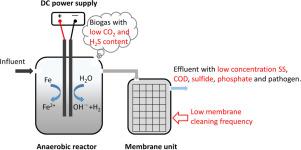Water Research ( IF 11.4 ) Pub Date : 2022-10-04 , DOI: 10.1016/j.watres.2022.119202 Zhetai Hu 1 , Min Zheng 1 , Shihu Hu 1 , Pei-Ying Hong 2 , Xueqing Zhang 1 , Veljko Prodanovic 3 , Kefeng Zhang 3 , Ilje Pikaar 4 , Liu Ye 5 , Ana Deletic 6 , Zhiguo Yuan 1

|
Although iron salts such as iron(III) chloride (FeCl3) have widespread application in wastewater treatment, safety concerns limit their use, due to the corrosive nature of concentrated solutions. This study demonstrates that local, electrochemical generation of iron is a viable alternative to the use of iron salts. Three laboratory systems with anaerobic membrane processes were set up to treat real wastewater; two systems used the production of either in-situ or ex-situ electrochemical iron (as Fe2+ and Fe2+(Fe3+)2O4, respectively), while the other system served as a control. These systems were operated for over one year to assess the impact of electrochemically produced iron on system performance. The results showed that dosing of electrochemical iron significantly reduced sulfide concentration in effluent and hydrogen sulfide content in biogas, and mitigated organics-based membrane fouling, all of which are critical issues inherently related to sustainability of anaerobic wastewater treatment. The electrochemical iron strategy can generate multiple benefits for wastewater management including increased removal efficiencies for total and volatile suspended solids, chemical oxygen demand and phosphorus. The rate of methane production also increased with electrochemically produced iron. Economic analysis revealed the viability of electrochemical iron with total cost reduced by one quarter to a third compared with using FeCl3. These benefits indicate that electrochemical iron dosing can greatly enhance the overall operation and performance of anaerobic membrane processes, and this particularly facilitates wastewater management in a decentralized scenario.
中文翻译:

电化学制铁强化废水厌氧膜处理
尽管铁盐如氯化铁 (III) (FeCl 3 ) 在废水处理中具有广泛的应用,但由于浓缩溶液的腐蚀性,安全问题限制了它们的使用。该研究表明,局部电化学生成铁是使用铁盐的可行替代方案。建立了三个具有厌氧膜工艺的实验室系统来处理实际废水;两个系统使用原位或非原位电化学铁(如 Fe 2+和 Fe 2+ (Fe 3+ ) 2 O 4,分别),而另一个系统用作控制。这些系统运行了一年多,以评估电化学生产的铁对系统性能的影响。结果表明,电化学铁的投加显着降低了污水中的硫化物浓度和沼气中的硫化氢含量,并减轻了基于有机物的膜污染,所有这些都是与厌氧废水处理可持续性相关的关键问题。电化学铁策略可以为废水管理带来多种好处,包括提高对总和挥发性悬浮固体、化学需氧量和磷的去除效率。甲烷产生的速率也随着电化学产生的铁而增加。3 . 这些好处表明,电化学铁剂量可以大大提高厌氧膜工艺的整体运行和性能,这尤其有助于分散场景中的废水管理。











































 京公网安备 11010802027423号
京公网安备 11010802027423号